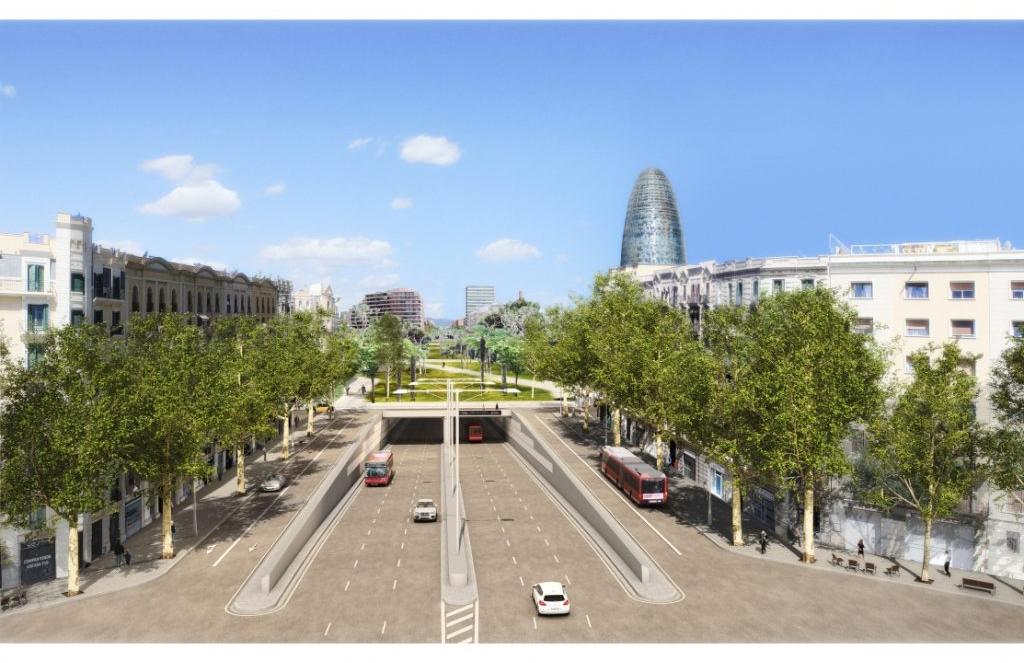Thessaloniki gets ready for its metro launch in November
The underground rapid transit lines have been under construction for almost two decades due to various project delays
 TheMayor.EU logo
TheMayor.EU logo 
The new tunnel in a project rendition, which shows when it will be fully operational, Source: Ajuntament de Barcelona
Its creation was considered one of the most complex urban planning operations in the city
This past weekend (6 November) saw the opening of the much-awaited tunnel under the Plaza de las Glòries in Barcelona. The new infrastructure facility moves the car traffic underground for a stretch of about one kilometre right in the core of the Catalonian capital, with the result of providing much-needed peace, quiet and clean air to the district.
Since 2019, the urban area that had been reclaimed from the street traffic above the ground has been converted into a green space (of 20,000 square metres), which got expanded a little bit more in September with the creation of the Clariana playground.
For now, the tunnel is in operation for car traffic going in the direction to Besós, or the northeast peripheries. The traffic arm in the opposite direction to Llobregat is expected to open up in January next year. The tunnel itself is located in the vicinity of the Agbar Tower, possibly the most famous contemporary architectural landmark of Barcelona.
It has been one of the most complex works carried out so far in the city and has resulted in a 957-meter tunnel (1,157 if the two ramps are added), with two independent unidirectional circulation tubes that reach a maximum depth of 25 meters in the area below the square. The tunnel thus goes under the L1 Metro line and the R1,2,3,4 light railway lines.
It consists of two sections: the first one, 508 meters long, between the streets of Los Castillejos and Badajoz, at a maximum depth with respect to the square and below the railway lines of 25 meters, and the second, 449 meters, between the streets of Badajoz and the Rambla del Poblenou, with an average depth of 10 meters.
The tunnel incorporates the latest technology in security measures and control, with emergency exits separated by a distance of 200 meters and new control of tunnel operators that has moved and opened its headquarters within the Municipal Services Center, in the Torrent de l'Olla street.
This infrastructure is expected to channel the traffic that circulates through this area, which is 78,000 vehicles per day. Of these vehicles, 43,000 circulate into the city and 35,000 out. Before the start of the works, the total figure at this neuralgic point reached 95,000 vehicles.

The underground rapid transit lines have been under construction for almost two decades due to various project delays

Now you can get your wine in Talence by paying directly in Bitcoin

That’s because the state has to spend money on updating the railway infrastructure rather than subsidizing the cost of the popular pass

Rethinking renewable energy sources for the urban landscape

The examples, compiled by Beyond Fossil Fuels, can inform and inspire communities and entrepreneurs that still feel trepidation at the prospect of energy transition

Now you can get your wine in Talence by paying directly in Bitcoin

The 10th European Conference on Sustainable Cities and Towns (ESCT) sets the stage for stronger cooperation between the EU, national and local level to fast track Europe's transition to climate neutrality.

At least, that’s the promise made by the mayor of Paris, Anne Hidalgo

The underground rapid transit lines have been under construction for almost two decades due to various project delays

At least, that’s the promise made by the mayor of Paris, Anne Hidalgo

Hostal de Pinós is located in the geographical centre of the autonomous region

Despite its church-y name, the district has long been known as the hangout spot for the artsy crowds

Urban dwellers across the EU are having a say in making their surroundings friendlier to people and the environment.

Forests in the EU can help green the European construction industry and bolster a continent-wide push for architectural improvements.

Apply by 10 November and do your part for the transformation of European public spaces

An interview with the Mayor of a Polish city that seeks to reinvent itself

An interview with the newly elected ICLEI President and Mayor of Malmö

A conversation with the Mayor of Lisbon about the spirit and dimensions of innovation present in the Portuguese capital














